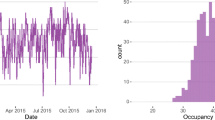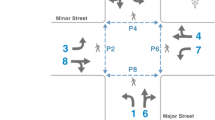Abstract
The delay vehicles experience at signalized intersections is one of the most important indicators for measuring intersection performance. The interpretation of delay variability evolvement at intersections gives a comprehensive insight into arterial traffic operation. Thus, an analytical model is proposed to investigate delay variability at coordinated intersections. Two different flow rates are assumed for both effective red and green periods in cumulative curves, through which the effect of signal coordination is incorporated in delay estimation. Then, an analogy of Markov chain process is used to explore the mechanism of stochastic overflow queue at signalized intersections. Numerical case studies show that with the decrease of arrival proportions during green, the shape of delay distribution in both undersaturation and oversaturation cases shifts faster towards higher values, implying that the coordination effect between paired intersections has a great effect on the delay distribution. As for delay fluctuation range, favorable coordination is demonstrated to be able to weaken the variability of delay estimates especially for undersaturation conditions.
Similar content being viewed by others
References
ZHENG Fang-fang, van ZUYLEN H J. Uncertainty and predictability of urban link travel time: A delay distribution based analysis [J]. Transportation Research Record: Journal of the Transportation Research Board, 2010, 2192: 136–146.
NEWELL G F. Approximation methods for queues with application to the fixed-cycle traffic light [J]. SIAM Review, 1965, 7(2): 223–240.
WEBSTER F V. Traffic signal settings [M]. Road Research Laboratory London, Her Majesty Stationary Office, 1958.
FU Li-ping, HELLINGA B. Delay variability at signalized intersections [J]. Transportation Research Record: Journal of the Transportation Research Board, 2000, 1790: 215–221.
GU Xiao-jun, LAN Chang-jen. Estimation of delay and its variability at signalized intersections [C]// TRB 88th Annual Meeting. Washington D C: TRB, 2009.
OLSZEWSKI P S. Modeling probability distribution of delay at signalized intersections [J]. Journal of Advanced Transportation, 1994, 28(3): 253–274.
ZHENG Fang-fang. Modeling urban travel time [D]. Delft, the Netherlands: Delft University of Technology, Transport and Planning, 2011.
HURDLE V F. Signalized intersection delay models-A primer for the uninitiated [J]. Transportation Research Record, Transportation Research Board, 1984, 971: 96–105.
SCATS. SCATS Traffic Reporter 6.4.2 user manual [R]. Australia, 2006.
VITI F. The dynamics and the uncertainty of delays at signals [D]. Delft: Delft University of Technology, 2006.
Highway capacity manual [M]. Washiongton D C: Transportation Research Board, 2000.
OLSZEWSKI P S. Traffic signal delay model for non-uniform arrivals [J]. Transportation Research Record: Journal of Transportation Research Board, 1990, 1287:42–53.
Highway capacity manual [M]. Washiongton D. C: Transportation Research Board, 2010.
STRONG D W, ROUPHAIL N M. Incorporating the effects of traffic signal progression into the proposed incremental queue accumulation (IQA) method [C]// TRB 85th Annual Meeting. Washington D.C: TRB, 2006.
KEITA Y M, SAITO M. Evaluation of the IQA delay estimation method [J]. Procedia-Social and Behavioral Sciences, 2011, 16: 792–802.
VAN ZUYLEN H J, VITI F. A probabilistic model for queues, delays and waiting time at controlled intersections [C]// TRB 86th Annual Meeting. Washington D. C: TRB, 2007.
BENEKOHAL R F, El-ZOHAIRY Y M. Progression adjustment factors for uniform delay at signalized intersections [J]. Transportation Research Record: Journal of Transportation Research Board, 1999, 1678: 32–41.
Author information
Authors and Affiliations
Corresponding author
Additional information
Foundation item: Project(51278455) supported by the National Natural Science Foundation of China; Project(2012M521175) supported by the National Science Foundation for Post-doctoral Scientists of China; Project(Bsh1202056) supported by and the Excellent Postdoctoral Science Foundation of Zhejiang Province, China
Rights and permissions
About this article
Cite this article
Chen, P., Liu, H., Qi, Hs. et al. Incorporating nonuniform arrivals in delay variability modeling at signalized intersections. J. Cent. South Univ. 21, 4021–4032 (2014). https://doi.org/10.1007/s11771-014-2391-8
Received:
Accepted:
Published:
Issue Date:
DOI: https://doi.org/10.1007/s11771-014-2391-8




